How to Draw a Lion Lesson Plan
Notes:
In this lesson students will use some common adjectives to draw things and sing a tricky song about describing animals.
Lesson Procedure:
Warm Up and Maintenance:
See our "Warm Up & Wrap Up" page.
New Learning and Practise:
1. Innovate the adjectives
You are going to innovate the following adjectives by drawing pictures on the lath: large / small, long / short, fat / thin, strong / weak, fast / slow. Don't worry if you are not very artistic – fifty-fifty uncomplicated line drawings will do.
First get-go past drawing two lines vertically down the board so yous divide the lath into three equal sections. Then do the following for each fix of adjectives:
- big / small: in the first section draw an apple (as shown below). Arm-twist "apple tree" and write "an apple" nether the moving picture. And then, in the second section, draw a really large apple tree – fill up the whole section. Teach / Elicit "large" and write "a big apple" under the moving-picture show. Finally, draw a actually small apple tree in the last section, teach / arm-twist "small" and write "a pocket-size apple".
Chorus each of the phrases three times. Then erase the pictures of the big and small apples. Invite ane student up to the board and pointing in the eye section say "draw a large apple". And then invite some other pupil up and say "depict a modest apple" pointing at the last section. Give each student a circular of applause.

- long / short: draw a pencil (long and short).
- fatty / sparse: draw a true cat (fat and thin).
- strong / weak: draw a human (strong – with big muscles, weak – a stick man with no muscles at all).
- fast / slow: draw a auto (a fast, sporty car, zooming around and an former, broken down car with smoke coming out of the exhaust).
For the residual of the adjectives, follow the same drawing on the board procedure:
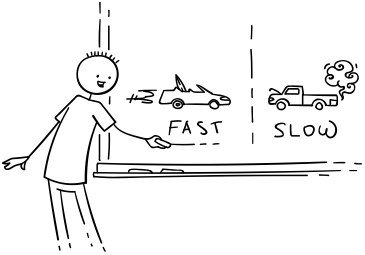
ii. Play "Adjectives Pictionary"
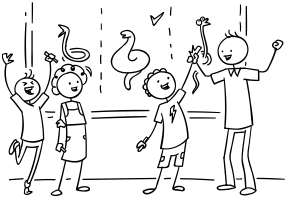 Offset by playing on the board so everyone understands how to play. Erase everything from the board except the two vertical lines from the previous activity. Invite three students to the board and stand them in front of each blank section on the lath and requite them a marker / chalk each. Say "Draw ii thin snakes and one fat snake". When the drawings are finished select a winner for the best picture. Play another round or two on the lath with unlike students (apply different adjectives and nouns each round).
Offset by playing on the board so everyone understands how to play. Erase everything from the board except the two vertical lines from the previous activity. Invite three students to the board and stand them in front of each blank section on the lath and requite them a marker / chalk each. Say "Draw ii thin snakes and one fat snake". When the drawings are finished select a winner for the best picture. Play another round or two on the lath with unlike students (apply different adjectives and nouns each round).
Side by side, put students into groups of iii and give each student a large piece of paper to draw on. Shout out the adjectives to draw and give everyone 1 minute to complete their drawings. At the stop of 1 minute go everybody to hold up their pictures – you are the gauge and yous have to select the best picture from each group of 3 students equally the winning picture. So move onto the next drawings – play until all the adjectives have been practiced. Here are some ideas for drawings:
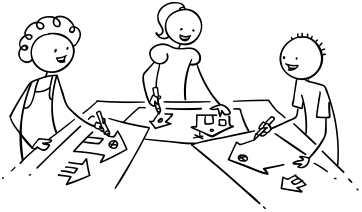
- thin / fatty snakes
- big / small houses
- fast / irksome snails
- long / curt carrots
- strong / weak animals (e.g. dogs, lions, elephants, etc.)
3. Sing "Allow'southward Look at the Animals (Adjectives Song)"
There are ii options for this song – either listening and doing the worksheet or singing along doing the gestures. Or you can do both! See the section below Gestures and activities for "Permit's Wait at the Animals".
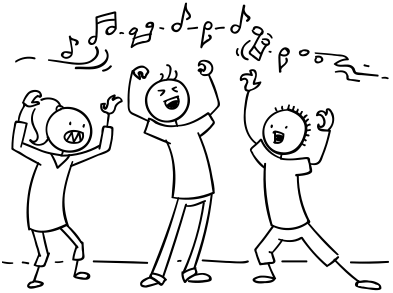 Lyrics for "Let's Expect at the Animals"
Lyrics for "Let's Expect at the Animals"
Chorus:
Permit's look at the animals,
Look, Look, Await! What'southward that?
Verse 1:
It's a bear and it's big.
It'south a bear and it's big.
It's a big bear!
Chorus
Verse 2:
It's a mouse and it'due south pocket-sized.
It's a mouse and it's modest.
It's a small mouse!
Chorus
Verse 3:
It's a snake and it'due south long.
It'southward a snake and it'southward long.
It's a long ophidian!
Chorus
Verse 4:
It'south a hippo and it'southward fatty,
It'southward a hippo and information technology'due south fatty,
It'due south a fat hippo!
Chorus
Poetry five:
It'due south a horse and it'south fast,
It's a horse and it's fast,
It's a fast horse!
Chorus
Verse 6:
It'south a lion and it'southward strong,
It's a panthera leo and it'southward strong,
It's a strong panthera leo!
(download MP3 here)
Gestures and activities for "Let's Wait at the Animals"
There are two options:
- Listening worksheet – use the "Allow'due south Look at the Animals Song - Listen and Circle" worksheet. Every bit yous play the song students listen and circle the animal which all-time fits the description in the song.
- Deportment. Go anybody to stand up and do the following deportment every bit they sing forth to the song:
- "Permit's look at the animals, Look, Look, Look!": put your palm above your eyes as if you are looking into the distance
- "What's that?": point at an imaginary brute
- bear: act big and strong and testify your claws
- mouse: act small and run around like a mouse
- ophidian: motion your body similar a slithering snake
- hippo: act big and fat (blow out your cheeks) and roar
- horse: gallop around similar a horse
- lion: act big and stiff and roar like a lion
We also have a video that you tin can stream in course to sing along with (Cyberspace connection required):

four. Play "Animal Races"
Now we will take fun running beyond the room using the fauna vocabulary in the vocal. Articulate all the tables and chairs from the room. Line anybody up at one finish of the room and lie a rope across the other stop of the room (the finish line). This isn't going to be an actual race – in that location will be no prizes for the first across the cease line, but prizes can be given for the best performance (stickers, stars side by side to names on the class affiche, praise, etc.).
Showtime modeling the first "race": say "Run like a big conduct" and demonstrate running like a bear (roaring and clawing the air). Then start the race and give your prize to the best performance (at this point arrive obvious that the fastest isn't the winner – the best operation wins!).
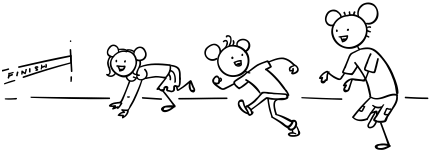
Now do more races:
- run like a large acquit
- run like a small mouse
- slither like a long serpent
- wade across the river like a fat hippo
- gallop like a fast horse
- chase a deer like a strong lion
 5. Exercise the "Adjectives – Draw the Opposites" worksheet
5. Exercise the "Adjectives – Draw the Opposites" worksheet
Sit everyone down at their desks and give out the worksheets. Take the students draw the opposites. As they are working, circulate and ask questions (due east.grand. What is this?, Is this a wearisome equus caballus?, etc.).
6. Read classroom reader "Monster Friends"
We'll end the lesson with a fun story. Before class, download and impress off the reader "Monster Friends". As you become through each page, point to the pictures, elicit each of the different torso parts and adjectives. Have fun asking other questions as well, such as the different colors of the monsters, for case:
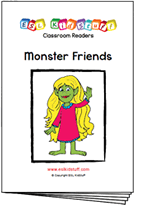 Teacher: (reading from the story) This is my friend Dullard (pointing at the picture). What color is Dullard?
Teacher: (reading from the story) This is my friend Dullard (pointing at the picture). What color is Dullard?
Students: He's blue!
Instructor: Yeah, that's correct! And look at his arms! Wow! He has ... (eliciting the adjective)
Students: Long!
Teacher: Aye! He has long arms. And is he brusque?
Students: No, he's tall!
Teacher: That's right! He's much taller than Susie!
 Get the students actually involved in the story past asking lots of questions and asking them if anyone in the course has similar characteristics to the monsters (due east.grand. the tallest student, the fastest student, etc.).
Get the students actually involved in the story past asking lots of questions and asking them if anyone in the course has similar characteristics to the monsters (due east.grand. the tallest student, the fastest student, etc.).
Afterwards reading the story, give out a reader worksheet to each pupil and have everyone match the monsters to their adjectives. So go through the answers as a grade.
---
Alternatively, scout our video version of the reader (Internet connection required):
Wrap Up:
1. Assign Homework: "Animal Adjectives – Write" worksheet.
2. Wrap upwardly the lesson with some ideas from our "Warm Up & Wrap Up" page.
Source: https://www.eslkidstuff.com/lesson-plans/describing-things.html
0 Response to "How to Draw a Lion Lesson Plan"
Post a Comment